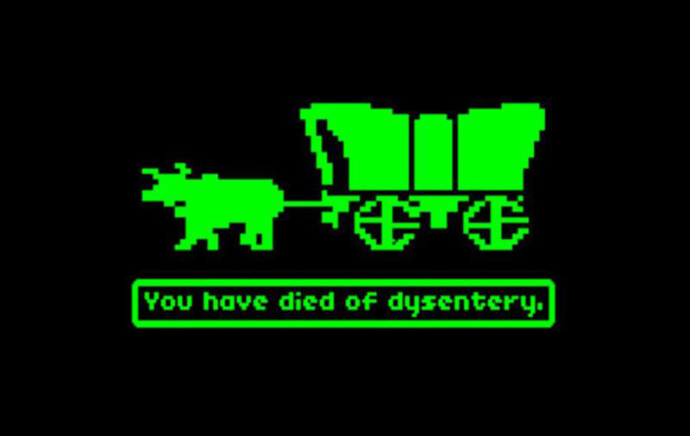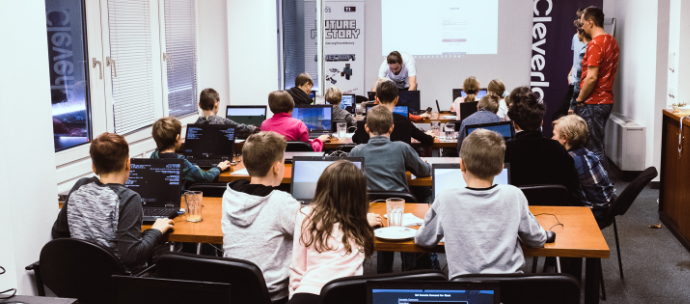In Autumn, we at Cleverlance in cooperation with the nVias foundation prepared a course on the foundations of programming for children. There are no boring lectures in the course though; instead, it uses the popular Minecraft game to teach basic concepts of coding and the students could try these out first-hand and experiment with them. And it was a huge success!
Since the time of Comenius, learning through play has been a crucial concept – actively involving students into the exploration of the new material, which then allows them to memorize and ingrain the information. It’s no wonder that information technologies have become a key tool for making the taught subject more interactive. Let’s have a brief look at the history of educational game and talk about what the future of such games might hold.
Programming, typing and dysentery
One of the first "games” on the computer is surprisingly similar to our effort to teach children to code. Logo Programming was in fact a simplified programming language, with a turtle-shaped mouse pointer as a bonus. In 1967, having a graphical interface was quite the luxury. Students moved the turtle cursor through programming orders, for example to create geometrical shapes.
A big player among the first educational games was the Apple II platform. For example in 1979 you could try capitalism in practice thanks to the Lemonade Stand economic game. A true break-through came with the Oregon Trail game, probably the most successful and popular educational game of all times. The task of the player was to get a family of American settlers in the first half of the 19th century to safety all the way across the United States. The game’s educational value lies in the historical accuracy of the obstacles that the digital family had to overcome. For example, a sudden death of one of the family members due to a sickness or injury was a common occurrence.
 Nintendo, famous for its mascot, the plumber Mario, was no stranger to the efforts to not only entertain but to also educate children. Unfortunately, their attempts, such as Mario Teaches Typing, weren’t very popular. As the name indicates, in this game Mario teaches you how to type on a keyboard. This is done in a boring way by moving Mario from one side of the map to another, while accompanied by the worst, squealing background music there has ever been in a Mario game. I can’t really recommend typing with Mario, but if you’re looking for a good way to have fun while learning to type, try Typing of the Dead. This is probably the only game where you can shoot a zombie in the head by hitting the spacebar at the right moment.
Nintendo, famous for its mascot, the plumber Mario, was no stranger to the efforts to not only entertain but to also educate children. Unfortunately, their attempts, such as Mario Teaches Typing, weren’t very popular. As the name indicates, in this game Mario teaches you how to type on a keyboard. This is done in a boring way by moving Mario from one side of the map to another, while accompanied by the worst, squealing background music there has ever been in a Mario game. I can’t really recommend typing with Mario, but if you’re looking for a good way to have fun while learning to type, try Typing of the Dead. This is probably the only game where you can shoot a zombie in the head by hitting the spacebar at the right moment.
What’s next? To worlds beyond
It seems that the most important modern milestone in the development of educational games is the rise of high-quality VR headsets. We at Cleverlance know a thing or two about this thanks to our cooperation with Virtual Medicine, a project that allows virtual reality users to have a thorough look at an anatomically accurate model of the human body. The use of VR in teaching biology and medicine is one of the major trends. One of the virtual apps, InMind, offers a close look at a human brain and its neurological connections.
A trip inside the human body, however, is nowhere near as popular as a VR trip to space. Once you put on your VR helmet, Titans of Space or Earth AR will take you through the Earth’s atmosphere and teach you about the solar system in a much more entertaining way than any geography teacher. My personal favourite educational project is Apollo 11 VR, and the name should tell you exactly where this one will take you. As a huge fan of the space program I am fascinated by the opportunity to try the first landing on the Moon live (well, almost).
 The original application of virtual reality, however, does more than get you to hard-to-reach places. With Public Speaking VR you can try being a presenter in a conference hall, university class or as part of a job interview. There are no limits to the applications of VR, all you need is good implementation – you can start for example with the digital twin technology.
The original application of virtual reality, however, does more than get you to hard-to-reach places. With Public Speaking VR you can try being a presenter in a conference hall, university class or as part of a job interview. There are no limits to the applications of VR, all you need is good implementation – you can start for example with the digital twin technology.
As time goes by, our approach to new technologies gradually takes down the barriers between practical, playful, interactive education and boring memorization of facts. No matter if you're a teacher trying to share your knowledge or someone who’s trying to learn something, there’s a plethora of fun and educational ways to choose from. I think if Comenius was alive today, he’d be delighted to put the VR helmet on and explore the wide spectrum of available educational software. And maybe he'd even come up with a revolutionary app for teaching Latin.
